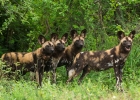Coming home: Bringing African Wild Dogs back into the Serengeti
Published: 14 May 2015
As the Tanzania Wildlife Research Institute re-introduce one of Africa's iconic species into Serengeti National Park, they are supported in their efforts by genetics researchers from the University of Glasgow.

As the Tanzania Wildlife Research Institute re-introduce one of Africa's iconic species into Serengeti National Park, they are supported in their efforts by researchers from the University of Glasgow.
African wild dog populations are decreasing across the continent, a response to habitat loss and disease such as canine distemper virus and rabies. In 1992, they disappeared from Serengeti National Park and were thought to be extinct until they began to appear east of the park in 2000. It was unclear where these "new" dogs had come from, until researchers from the Institute began to investigate. Genetic analysis by our researchers showed that the dogs were not new colonizers at all, but the remnants of the original Serengeti populations. The dogs had simply come home! The work was also able to demonstrate that, even though the population had dropped and re-bounded, no evidence of inbreeding depression was found. The population was genetically healthy and diverse.
Despite the good news, the presence of the wild dogs outside the park was not without problems. Instead of hunting antelope, the dogs were hunting farm animals, and the clash with the human inhabitants of the areas meant measures had to be taken to ensure their survival and the continued support of the community for their conservation. So began efforts to reintroduce the dogs into Serengeti National Park, where they could live without conflict with their human neighbours. The Serengeti Painted Wolves Project is coordinating the efforts to bring the dogs back to their ancestral home. So far 66 dogs have been reintroduced to the park, packs are successfully hunting, and there have been no conflicts with pastoralists.
The reintroduction also opens the doors for many new research questions about how the dogs will integrate into the park after an absence of almost 2 decades. With our research teams studying the ecology of the park and supporting TAWIRI's efforts, understanding how to preserve this species and maintaining open dialogue with local communities and managers will form a large part of their work in the coming years.
First published: 14 May 2015
Partners
People
To learn more
Article - Marsden et al. Inferring the ancestry of African wild dogs that returned to the Serengeti-Mara

